It’s funny the places you miss, when you can’t go there. To my surprise in my village home, I catch myself missing the streets and architecture of London, the new details I notice every time I walk along Piccadilly or stroll through Spitalfields.
But in contrast to those city streets, the site I yearn for most this blossom-filled spring is Old Campden House, amid its glorious Cotswold setting. I’ve known it since schooldays and it feels part of my DNA. I’d booked a stay in the East Banqueting Houses this May weekend, a treat around participation in the annual Chipping Campden Literary Festival. Of course, as for so many other disappointed Landmarkers, that’s not happening this year.
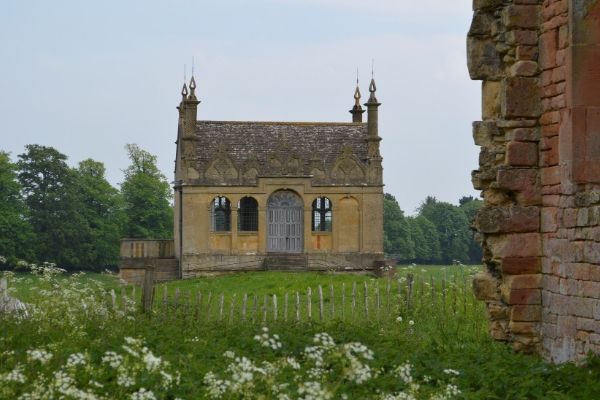
A froth of Queen Anne’s Lace behind the House ruins with the East Banqueting House beyond.
Yet I can still, even if only imagination, follow every yard of my road off the escarpment to Campden, down through the fresh new beech trees, tracing in reverse the retreat of the notorious Col Henry Bard and his uncouth Royalist garrison that fateful night of 10th May 1645, as they marched to join Prince Rupert at Evesham. The Prince had also ordered that Campden House be torched. As they marched away up the hill, it blazed in the plain below, ‘a house, as my lord Campden says, that hath cost £30,000 in building and furniture.’ Perhaps they could make out the silhouettes of townspeople scurrying back and forth in vain, perhaps heard their cries as smoke and sparks billowed into the night sky.
But as I drive on in the May-time, saluting Viscount Campden, Baptist Hicks’, little stone conduit house as the road drops down into the town, all will be frothing green and white now, the may in flower, Queen Anne’s Lace gracing the verges. Past the pillowy clipped yew hedges and thatch of Broad Campden, past the Old Silk Mill where Hart the silversmith made up the designs for C R Ashbee (and his direct descendants still do) and right into ‘the most beautiful village street now left on the island’ in my humble (and historian G M Trevelyan’s) opinion.
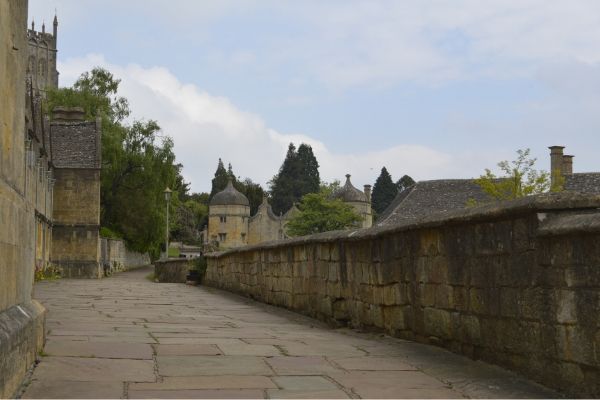 Turn right into Church Street...past the Almshouses...
Turn right into Church Street...past the Almshouses...
Past fine 14th-century Grevel House, built on the profits of Cotswold sheep, where as a Brownie I was tucked up in bed by Dr Olliffe so Girl Guides could practise taking my temperature. Walking now, turn right into Church Street, into the approach to the fine wool church so shamelessly appropriated in 1612 as backdrop to his new great house by that late Tudor parvenu, Baptist Hicks, mercer and money lender to the Court, and one of the (many) new knights created by James I & VI when he came south to London in 1603.
The honey-coloured oolitic limestone (thanks, Mr Watkins, my 2nd year geography teacher) of the almshouses will be glowing warm in the sun, set with Hicks’ coat of arms and ambitious motto, Non metam (Not Yet At My Goal). But sic transit gloria mundi: beyond the sweeping gateway with its little pepperpot lodges, across the lush long meadow grass studded with buttercups, we find not Lord Campden’s mighty mansion but just a stump of masonry, rose-stained by the flames, all that remains after the fire and the plunder of the townsfolk. Yet miraculously, it still flanked by those two irresistibly delicious Banqueting Houses, with their barley sugar twist chimneys and crests of strapwork.
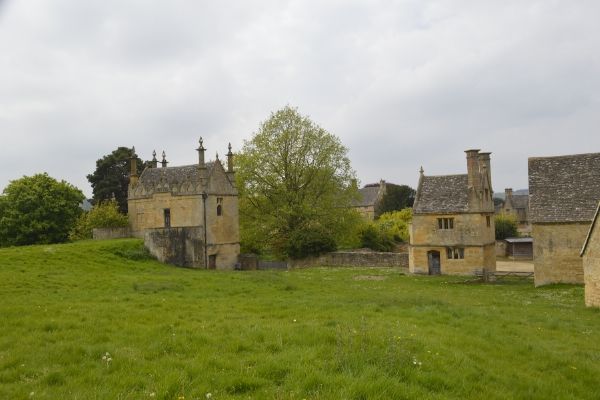 Barley sugar twist chimneys: the West Banqueting House and Almonry.
Barley sugar twist chimneys: the West Banqueting House and Almonry.
Salute them each, but then walk onto the raised grassy bank in front of the portico so cruelly torched by Bard’s men – and then stand, and look, look out over this most beautifully Cotswold landscape. Mentally greet each blurred but still visible element: parterre, raised walkways, reeds beyond marking sally beds and ornamental canal – and then, beyond, drink in that Cotswold view of fields hedges, willows, trees and hillsides all clothed in their May-time best.
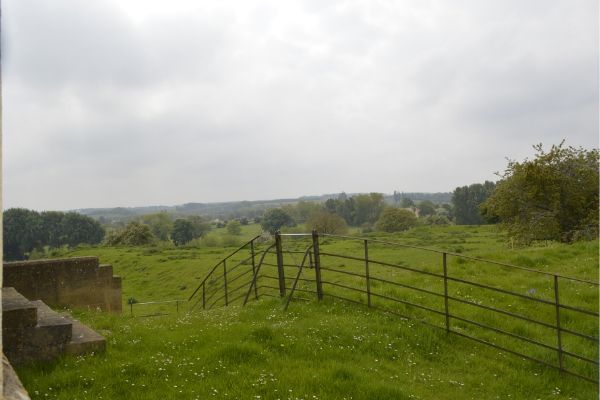 The view from the steps of the East Banqueting House.
The view from the steps of the East Banqueting House.
Overhead, a sky lark sings, and sheep move slowly and contentedly cropping the grass on the parterre, all scars healed, so many memories faded, and only the timeless beauty of an ancient site waiting for us to add our own memories. It’s there, it’s always there, as clearly in the mind’s eye as if I were standing there.
'Till next May, then!
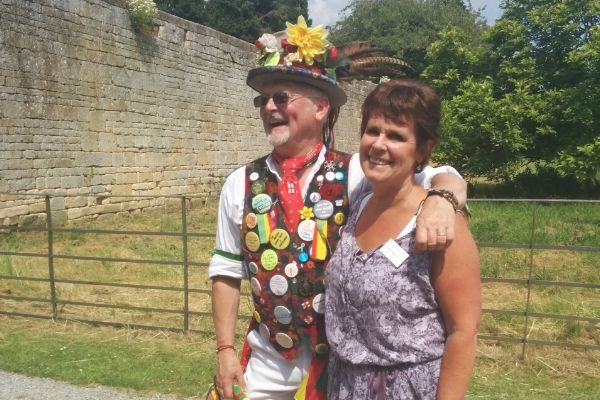 Caroline with the Captain of the Campden Morris Men at a 2014 Open Day.
Caroline with the Captain of the Campden Morris Men at a 2014 Open Day.
'And therefore take the present time,
With a hey, and a ho, and a hey nonino,
For love is crownèd with the prime
In springtime, the only pretty ring time,
When birds do sing, hey ding a ding, ding;
Sweet lovers love the spring.'
As You Like It, Act V scene iii.